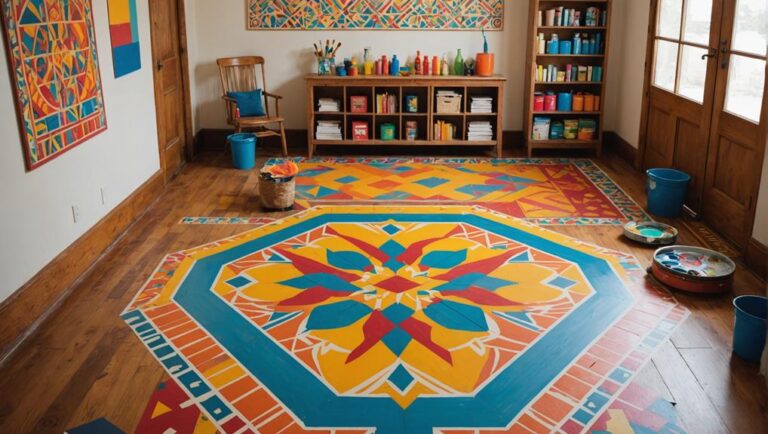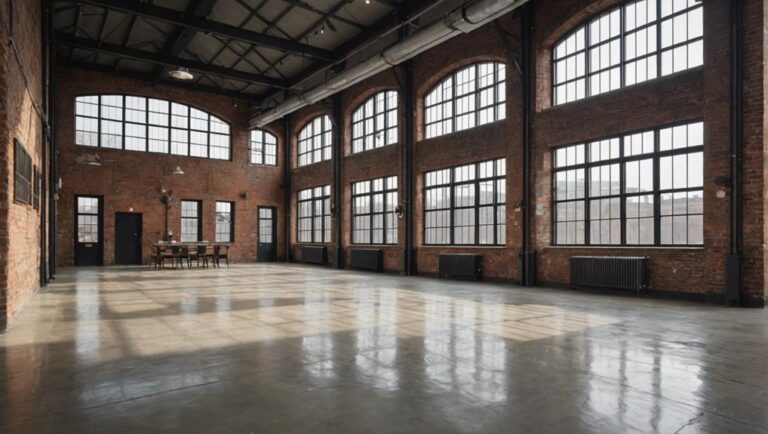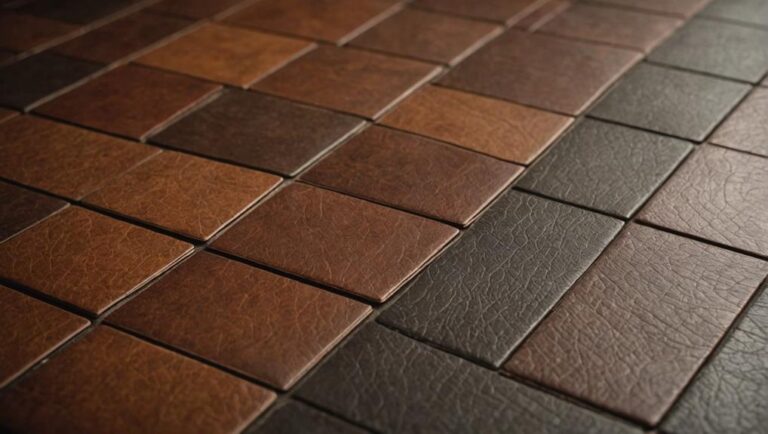Refinishing your concrete floors can dramatically enhance their appearance and extend their lifespan. You'll benefit from cost efficiency, as it's cheaper than total replacement. Start by evaluating the condition of your floor, then clean it thoroughly to remove dirt and stains. Use a concrete grinder for surface preparation, followed by polishing methods to attain your desired sheen. Choose between acid-based or water-based stains to add color, and seal the surface to protect against wear. Regular maintenance and proper sealing techniques will guarantee longevity. For more detailed steps and tips, essential to the refinishing process, further exploration awaits.
Benefits of Refinishing Concrete
Refinishing concrete floors offers a range of benefits that can markedly enhance both the aesthetic and functional aspects of your space. One of the primary advantages is the significant cost savings associated with refinishing compared to full replacement. When you choose to refinish rather than replace, you're not only minimizing waste but also reducing labor and material costs associated with a new installation. This economical approach allows you to allocate funds to other necessary improvements within your environment.
In addition to the financial benefits, refinishing provides a remarkable aesthetic enhancement. With various finishes available, including polished, stained, or stamped options, you can transform an ordinary concrete floor into a visually appealing surface that complements your design vision. This enhancement is particularly valuable in commercial settings, where creating an inviting atmosphere can boost customer experience and engagement.
Moreover, refinishing concrete floors can improve safety. High-quality sealers and finishes can enhance slip resistance, thereby reducing the risk of accidents in high-traffic areas. It's essential to select appropriate products that meet safety standards to guarantee the longevity of your refinished floors while providing a secure walking surface.
Ultimately, the benefits of refinishing concrete floors are multifaceted. From cost savings to aesthetic enhancement and improved safety, refinishing presents an effective solution for maintaining and upgrading your space without the need for extensive renovations. By investing in this process, you're making a wise decision that pays off in both the short and long term.
Tools and Materials Needed
To effectively refinish your concrete floors, you'll need a specific set of tools and materials. This includes an overview of essential tools like grinders, polishers, and vacuums, along with a checklist of required materials such as sealants and coatings. Having the right equipment ready will guarantee a smooth and efficient refinishing process.
Essential Tools Overview
Gathering the right tools and materials is vital for a successful concrete floor refinishing project. You'll need to start with a concrete grinder, which is important for effective floor preparation. This tool allows you to remove old finishes and create a smooth surface. Don't forget a vacuum attachment to minimize dust and guarantee a safe working environment.
Next, invest in a floor buffer for polishing. A high-quality buffer will help achieve that desired sheen without damaging the concrete. For edges and corners, a hand-held grinder is invaluable, allowing you to reach areas the larger grinder can't.
Safety precautions are paramount. Equip yourself with personal protective equipment (PPE), including safety goggles, gloves, and a respirator mask to protect against dust inhalation and chemical exposure. You'll also need a sturdy extension cord to power your tools safely and efficiently.
Lastly, verify you have a level and measuring tape on hand for precise measurements during your project. By gathering these essential tools, you'll create a safer, more effective workspace and set yourself up for success in refinishing your concrete floors.
Required Materials Checklist
Before diving into your concrete floor refinishing project, it's important to compile a thorough materials checklist. First, you'll need a high-quality concrete grinder to smooth the surface effectively. Opt for dust containment systems to minimize airborne particles, ensuring safety during the process.
Next, gather eco-friendly options like low-VOC sealers and stains that won't compromise indoor air quality. These products often come with cost considerations; however, investing in sustainable materials can save you money in the long run by enhancing durability.
Don't forget safety gear, including respirators, safety goggles, and gloves, to protect yourself from dust and chemicals. You'll also require a mop, bucket, and water for cleaning the floor pre- and post-refinishing.
Preparing Your Floor
Typically, preparing your concrete floor is an essential step that sets the foundation for a successful refinishing project. Before diving into the refinishing process, you need to conduct a thorough floor assessment. This involves examining the entire surface for cracks, stains, or any signs of moisture infiltration. Document any areas requiring special attention, as they may need to be addressed before you can proceed with refinishing.
Once the floor assessment is complete, focus on surface preparation. Begin by cleaning the floor meticulously; this includes sweeping away dust and debris, followed by mopping with a suitable cleaner to eliminate any grease or oils. For stubborn stains, you may need to use a concrete cleaner or degreaser, making sure you follow safety guidelines such as wearing gloves and goggles.
Next, check for any surface imperfections. If you find cracks or holes, fill them with an appropriate concrete patching compound. Allow ample time for the compound to cure, as this guarantees a uniform surface for refinishing.
Techniques for Refinishing
When refining concrete floors, you'll want to explore various techniques that enhance both aesthetic and durability. This includes grinding and polishing methods for surface preparation, as well as staining and coloring options to achieve your desired look. Finally, understanding sealing and finishing techniques is vital for protecting your investment and ensuring longevity.
Grinding and Polishing Methods
Grinding and polishing methods are vital techniques for achieving a smooth, aesthetically pleasing finish on concrete floors. By employing diamond grinding, you can effectively prepare the surface, removing imperfections and guaranteeing a level base for further refinishing. This process involves using specialized machines equipped with diamond-tipped pads that grind down the concrete surface to the desired smoothness.
Here's a quick overview of common methods:
| Method | Description |
|---|---|
| Diamond Grinding | Utilizes diamond-tipped pads for surface preparation and leveling. |
| Wet Polishing | Reduces dust and heat while enhancing the shine. |
| Dry Polishing | Employs a dust recovery system for a cleaner environment. |
| Buffing | Adds a final layer of shine, typically using a softer pad. |
Safety should always be a priority. Confirm you're wearing appropriate personal protective equipment (PPE) such as safety goggles, gloves, and a dust mask. Proper ventilation is also vital when using grinding and polishing equipment to minimize inhalation of concrete dust. By following these methods, you'll achieve a polished finish that not only looks great but also enhances the durability of your concrete floors.
Staining and Coloring Options
After achieving a polished surface through grinding and polishing, the next step in refinishing concrete floors involves selecting the right staining and coloring options. You'll find that stain application is a vital process that can dramatically enhance the aesthetic appeal of your concrete. There are two primary types of stains: acid-based and water-based. Acid stains react chemically with the concrete, creating a variegated, translucent finish, while water-based stains offer a broader palette and are easier to apply.
When applying stains, it's important to verify the surface is clean and dry to achieve ideal adhesion. You'll want to use a high-quality sprayer or roller for even application, and remember to wear safety gear, including gloves and masks, to protect yourself from harmful fumes.
Color blending is another technique that can be employed to achieve unique finishes. By layering different stains, you can create depth and complexity in your flooring. Experimenting with various color combinations can result in a personalized outcome that elevates your space. Always test your stain on a small, inconspicuous area to confirm you're happy with the results before committing to the entire floor.
Sealing and Finishing Techniques
To achieve a durable and visually appealing finish for your refinished concrete floor, sealing is an essential step that shouldn't be overlooked. Proper sealing methods not only enhance the aesthetics but also protect against wear, staining, and moisture infiltration.
When selecting finishing products, consider the specific needs of your environment. For instance, high-traffic areas may require more robust solutions, while residential spaces might benefit from lighter finishes. Here's a comparison of common sealing methods and finishing products:
| Sealing Method | Description |
|---|---|
| Acrylic Sealers | Quick-drying, suitable for light-duty use. |
| Epoxy Sealers | Durable, ideal for high-traffic areas. |
| Polyurethane Sealers | Provides excellent chemical resistance. |
| Penetrating Sealers | Absorbs into the concrete for long-lasting protection. |
| Water-Based Sealers | Low VOC, safer for indoor use. |
Before applying any sealing method, verify the surface is clean and properly prepared. Always follow the manufacturer's instructions for application and curing times to guarantee the best results and maintain safety. Choosing the right sealing and finishing techniques will provide a long-lasting, beautiful floor that meets your needs.
Choosing the Right Finish
How do you determine the best finish for your refinished concrete floors? The choice between a matte finish and a glossy finish greatly impacts both aesthetics and functionality. A matte finish offers a more subdued appearance, reducing glare and providing a non-slip surface, which is essential for safety, particularly in high-traffic areas or homes with children and elderly individuals. This type of finish minimizes reflections, making it an excellent choice for spaces where lighting might create hazards.
On the other hand, a glossy finish enhances color vibrancy and provides a polished look that can elevate the overall ambiance of your space. While glossy finishes are visually appealing, they can become slippery when wet, posing a potential safety risk. If you opt for a glossy finish, consider applying anti-slip additives or treatments to maintain safety without sacrificing aesthetics.
When choosing the right finish, think about the room's purpose, the level of foot traffic, and your personal style preferences. For example, in a living room or a gallery, a glossy finish may be suitable. In contrast, a garage or workshop might benefit more from the practicality of a matte finish.
Ultimately, the right finish should not only reflect your design vision but also prioritize safety and durability. Assess your environment carefully to make an informed decision, ensuring that your refinished concrete floors serve both form and function effectively.
Step-by-Step Refinishing Process
Starting the refinishing process for your concrete floors involves several essential steps that must be executed with precision. Following these steps will guarantee a successful outcome while also considering eco-friendly options for your DIY refinishing project.
- Preparation: Clear the area of all furniture and debris. Confirm the floor is clean by sweeping and mopping it thoroughly.
- Repair: Inspect the concrete for cracks or damage. Fill any cracks with a suitable concrete patching compound and allow it to cure completely.
- Grinding: Use a concrete grinder to remove the old finish and any surface imperfections. When grinding, wear appropriate protective gear, including a dust mask and safety goggles.
- Cleaning: After grinding, vacuum the dust and wash the floor with a mild detergent. Rinse thoroughly to remove any soap residue, which can affect the new finish.
- Applying the Finish: Choose an eco-friendly sealant or stain, and apply it evenly using a roller or sprayer. Make sure to follow the manufacturer's guidelines for application and drying times.
Throughout the process, prioritize safety by wearing gloves and confirming proper ventilation in the work area. By following these steps carefully, you'll achieve beautifully refinished concrete floors while using eco-friendly options that reflect your commitment to sustainability. Remember, taking your time with each step leads to a stunning and durable finish.
Maintenance Tips for Longevity
Maintaining your newly refinished concrete floors is essential for guaranteeing their longevity and preserving their aesthetic appeal. To achieve this, you'll need to establish a regular cleaning frequency. Ideally, you should sweep or vacuum your floors at least once a week to remove dirt and debris that can cause scratches. For deeper cleaning, use a pH-neutral cleaner specifically formulated for concrete surfaces every month. Avoid harsh chemicals, as they can damage the finish.
In addition to routine cleaning, implementing preventative measures can greatly extend the life of your floors. Consider placing mats at entry points to reduce the amount of dirt and moisture tracked onto the surface. Use furniture pads under heavy items to prevent scratches and dents. If your floors are exposed to direct sunlight, applying window treatments can help mitigate UV damage that may fade colors over time.
It's also wise to address spills immediately. Use a soft cloth to blot spills, avoiding abrasive materials that could scratch the surface. For tougher stains, consult a professional for appropriate removal techniques.
Lastly, periodically inspect your floors for signs of wear, such as dullness or uneven texture. If you notice any issues, it may be time to reapply a protective sealant or refinishing to maintain that fresh look. By following these maintenance tips, you can guarantee your refinished concrete floors remain beautiful and durable for years to come.
Frequently Asked Questions
How Long Does the Refinishing Process Typically Take?
The refinishing process typically takes a few days to complete, depending on the refinishing techniques used and the project timeline. You'll need to factor in preparation, application, and curing times. For instance, if you're applying a new finish, allow at least 24 hours for it to cure properly before use. Always prioritize safety by ensuring proper ventilation and using protective gear throughout the process to minimize exposure to fumes and dust.
Can I Refinish My Concrete Floors Myself?
"You can't make an omelet without breaking eggs." If you're considering refinishing your concrete floors yourself, you'll need the right tools, like a grinder, sander, and sealant. Preparation steps include cleaning the surface thoroughly and repairing any cracks. Safety is paramount—always wear protective gear, including goggles and masks. Proper planning and execution can lead to a successful DIY project, but be cautious and guarantee you're equipped for the task at hand.
Is Refinishing Safe for Indoor Air Quality?
Refinishing can impact indoor air quality, especially if you're using certain chemicals. It's essential to prioritize chemical safety by choosing low-VOC (volatile organic compounds) products. Guarantee proper ventilation during the process to minimize airborne contaminants. Using masks and protective gear can further enhance safety. Always check the manufacturer's guidelines for any products you're considering, as they often provide recommendations for maintaining healthy indoor air quality during and after refinishing.
What Types of Concrete Can Be Refinished?
Think of concrete as a canvas waiting for a masterstroke. You can refinish various types of concrete, including stained concrete, which adds depth and color, and polished concrete, known for its sleek, shiny finish. Both options enhance aesthetics while improving durability. It's crucial to assess the existing surface condition before refinishing, ensuring safety and longevity. With the right technique, you can transform ordinary concrete into a stunning, functional masterpiece.
Will Refinishing Hide Existing Cracks in the Concrete?
Refinishing can improve the appearance of your concrete, but it won't completely hide existing cracks. Before you start, guarantee proper surface preparation, which includes cleaning and evaluating any damage. Crack repair is essential to fill in and stabilize any visible fissures. Once repaired, refinishing can create a smoother, more uniform surface, but deep or wide cracks may still be noticeable. Prioritize safety by using appropriate materials and protective gear during the process.




